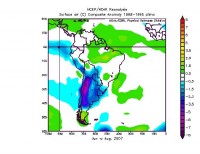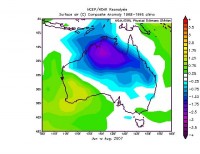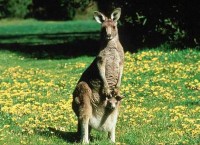
|
Oct 22, 2007
Why I Would Rather Be Called a Heretic on Global Warming
By David Bellamy, Times Online
Am I worried about man-made global warming? The answer is “no” and “yes”.
No, because the Hadley Centre for Climate Prediction has come up against an “inconvenient truth”. Its research shows that since 1998 the average temperature of the planet has not risen, even though the concentration of carbon dioxide in the atmosphere has continued to increase. Yes, because the self-proclaimed consensus among scientists has detached itself from the questioning rigours of hard science and become a political cause. Those of us who dare to question the dogma of the global-warming doomsters who claim that C not only stands for carbon but also for climate catastrophe are vilified as heretics or worse as deniers.
I am happy to be branded a heretic because throughout history heretics have stood up against dogma based on the bigotry of vested interests. But I don’t like being smeared as a denier because deniers don’t believe in facts. The truth is that there are no facts that link the concentration of atmospheric carbon dioxide with imminent catastrophic global warming. Instead of facts, the advocates of man-made climate change trade in future scenarios based on complex and often unreliable computer models.
Name-calling may be acceptable in politics but it should have no place in science; indeed, what is happening smacks of McCarthyism, witch-hunts and all. Scientific understanding, however, is advanced by robust, reasoned argument based on well-researched data. So I turn to simple sets of data that are already in the public domain. The last peak global temperatures were in 1998 and 1934 and the troughs of low temperature were around 1910 and 1970. The second dip caused pop science and the media to cry wolf about an impending, devastating Ice Age. Our end was nigh! Read full story next.
Oct 15, 2007
Frigid Southern Hemisphere Winter an Omen for the Northern Hemisphere?
By Eugenio Hackbart, METSUL and Joe D’Aleo, ICECAP
Eugenio wrote: “It was an outstanding winter for us in part of South America. Buenos Aires in Argentina had its first snow since 1918. Southern Brazil experienced 4 consecutive months of cold and below average temperature with daily and all-time records. Santiago, Chilean capital, had its coldest winter since the Little Ice Age. The last time it was so cold there was in 1885.”
Indeed that can be seen with the NOAA means temperature analysis for their winter here. Departures are in degrees Celsius (7 degree anomalies correspond to about 12 degrees Fahrenheit).

Eugenio goes on “Our winter here in the southern hemisphere raised serious questions among people concerned on global warming. Scientists were predicting warmer winters. So, what happened, people asked. I believe questions will be raised in the next months also in the US. The climate behavior here is this part of the Southern Hemisphere is somewhat connected to the trend in the Midwest and Northeast United States year after year and may anticipate the trend from season to season. So, first of all, NOAA released this week its winter outlook. But I don’t’ buy it. No way !! I strongly suspect this marked cooling trend in the Pacific will result in below average temperature months in larger areas of the US.”
By the way, much of Australia, too had a cold winter, with a record cold June.

Read more here.
Oct 14, 2007
Gore Gets a Cold Shoulder
By Steve Lytte, Sydney Morning Herald
One of the world’s foremost meteorologists has called the theory that helped Al Gore share the Nobel Peace Prize “ridiculous” and the product of “people who don’t understand how the atmosphere works”. Dr William Gray, a pioneer in the science of seasonal hurricane forecasts, told a packed lecture hall at the University of North Carolina that humans were not responsible for the warming of the earth.
His comments came on the same day that the Nobel committee honoured Mr Gore for his work in support of the link between humans and global warming. “We’re brainwashing our children,” said Dr Gray, 78, a long-time professor at Colorado State University. “They’re going to the Gore movie [An Inconvenient Truth] and being fed all this. It’s ridiculous.”
But Dr Gray, whose annual forecasts of the number of tropical storms and hurricanes are widely publicised, said a natural cycle of ocean water temperatures - related to the amount of salt in ocean water - was responsible for the global warming that he acknowledges has taken place. However, he said, that same cycle meant a period of cooling would begin soon and last for several years. “We’ll look back on all of this in 10 or 15 years and realise how foolish it was,” Dr Gray said.
During his speech to a crowd of about 300 that included meteorology students and a host of professional meteorologists, Dr Gray also said those who had linked global warming to the increased number of hurricanes in recent years were in error. He cited statistics showing there were 101 hurricanes from 1900 to 1949, in a period of cooler global temperatures, compared to 83 from 1957 to 2006 when the earth warmed. Read more here.
Oct 11, 2007
Chilly Temperatures During the Maunder Minimum
NASA Earth Observatory
Many things can change temperatures on Earth: a volcano erupts, swathing the Earth with bright haze that blocks sunlight, and temperatures drop; greenhouse gases trap heat in the atmosphere, and temperatures climb. From 1650 to 1710, temperatures across much of the Northern Hemisphere plunged when the Sun entered a quiet phase now called the Maunder Minimum. During this period, very few sunspots appeared on the surface of the Sun, and the overall brightness of the Sun decreased slightly. Already in the midst of a colder-than-average period called the Little Ice Age, Europe and North America went into a deep freeze: alpine glaciers extended over valley farmland; sea ice crept south from the Arctic; and the famous canals in the Netherlands froze regularly—an event that is rare today (Icecap Note: happened in the winter of 2005/06).

The impact of the solar minimum is clear in this image, which shows the temperature difference between 1680, a year at the center of the Maunder Minimum, and 1780, a year of normal solar activity, as calculated by a general circulation model. Deep blue across eastern and central North America and northern Eurasia illustrates where the drop in temperature was the greatest. Nearly all other land areas were also cooler in 1680, as indicated by the varying shades of blue. The few regions that appear to have been warmer in 1680 are Alaska and the eastern Pacific Ocean (left), the North Atlantic Ocean south of Greenland (left of center), and north of Iceland (top center).
If energy from the Sun decreased only slightly, why did temperatures drop so severely in the Northern Hemisphere? Climate scientist Drew Shindell and colleagues at the NASA Goddard Institute for Space Studies tackled that question by combining temperature records gleaned from tree rings, ice cores, corals, and the few measurements recorded in the historical record, with an advanced computer model of the Earth’s climate. Read more here.
Oct 11, 2007
They Will ‘Roo’ the Day
By Karen Collier, Herald Sun
Greenpeace urges kangaroo consumption to fight global warming. More kangaroos should be slaughtered and eaten to help save the world from global warming, environmental activists say. The controversial call to cut down on beef and serve more of the national symbol on our dinner plates follows a report on curbing greenhouse gas emissions damaging the planet. Greenpeace energy campaigner Mark Wakeham urged Aussies to substitute some red meat for roo to help reduce land clearing and the release of methane gas. “It is one of the lifestyle changes we can make,” Mr Wakeham said. “Changing our meat consumption habits is a small way to make an impact.” The eat roo recommendation is contained in a report, Paths to a Low-Carbon Future, commissioned by Greenpeace and released today.

It also coincides with recent calls from climate change experts for people in rich countries to reduce red meat and switch to chicken and fish because land-clearing and burping and farting cattle and sheep were damaging the environment.
Today’s report by leading scientist Dr Mark Diesendorf, from the University of NSW, says greenhouse gas emissions need to be slashed by at least a third by 2020 to avoid a climate change catastrophe. His recommendations include: (1) Reducing beef consumption and increasing kangaroo meat production, (2) Cutting gas and coal production. (3) Halting land clearing and deforestation, (4) Shifting to renewable energy such as wind power and bioelectricity from crop residues. “The world is currently on track to experience runaway global warming with average temperatures soon to exceed 2 degrees above pre-industrial levels, Dr Diesendorf said. “We face a catastrophe unless there is urgent action to cut greenhouse gas emissions by at least 30 per cent by 2020.”
A major report by the CSIRO and Bureau of Meteorology released this month warned average temperatures will rise 1C by 2030 and could increase as much as 5C in Australia by 2070 unless global greenhouse emissions are cut dramatically.
Icecap note: Dr. Diesendorf seems to have left off two of the most important sources of hot air in the Southern Hemisphere, CSIRO and the BOM
|
|
|
|






